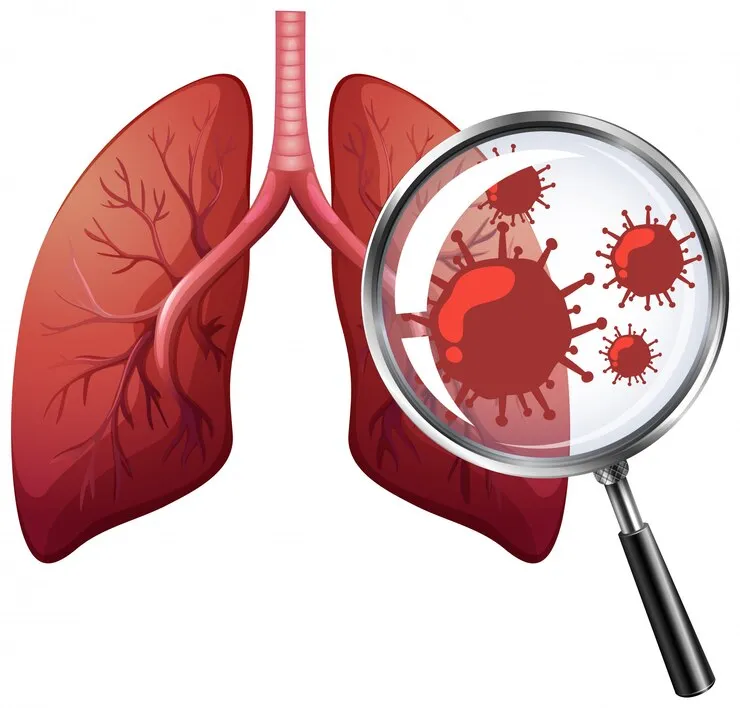- C-6&7, 6362, Pocket 6, Sector C, Vasant Kunj, New Delhi
- Mon - Sat: 16:00 - 20:00 PM

Lung Cancer treatment
What is Lung Cancer
Lung cancer is a type of cancer that starts in the lungs. It is a condition characterized by the uncontrolled growth of abnormal cells in lung tissues, leading to the formation of tumors. These tumors can interfere with the normal functioning of the lungs, affecting their ability to provide oxygen to the body. The Lung Cancer treatment modalities for lung cancer include surgery, radiation therapy, chemotherapy, targeted therapy, and immunotherapy.
There are two main types of lung cancer and treatment: non-small cell lung cancer (NSCLC) and small cell lung cancer (SCLC). NSCLC is more common, accounting for about 85% of all lung cancers, while SCLC is a more aggressive form that tends to grow rapidly and spread early.
what are the types of lung cancer
Lung cancer is broadly classified into two main types based on the appearance of the cancer cells under a microscope: non-small cell lung cancer (NSCLC) and small cell lung cancer (SCLC). These types have different characteristics, treatments, and prognoses.
Non-Small Cell Lung Cancer (NSCLC):
- NSCLC is the more common type, accounting for approximately 85% of all lung cancers.
- There are three main subtypes of NSCLC:
- Adenocarcinoma: This subtype often occurs in the outer regions of the lung and is more common in non-smokers or former light smokers. It tends to grow more slowly than other types.
- Squamous Cell Carcinoma: Typically found in the central part of the lungs, squamous cell carcinoma is often linked to a history of smoking and may be associated with coughing and chest pain.
- Large Cell Carcinoma: This is a less common subtype that can occur in any part of the lung and tends to grow quickly.
Small Cell Lung Cancer (SCLC):
- SCLC accounts for about 15% of lung cancers and is characterized by small, oat-shaped cells.
- SCLC is usually more aggressive and tends to grow rapidly, often spreading to other parts of the body early in the course of the disease.
- This type of lung cancer is strongly associated with smoking.
Symptoms of Lung Cancer
The symptoms of lung cancer can vary, and in the early stages, lung cancer may not cause noticeable symptoms. When symptoms do occur, they can be associated with the location and size of the tumor, as well as its impact on nearby tissues or organs. Common symptoms of lung cancer include:
Persistent Cough: A chronic cough that doesn’t go away or worsens over time is a common symptom of lung cancer. This may be accompanied by changes in coughing patterns.
Chest Pain: Ongoing chest pain that may be sharp, dull, or persistent. The pain may be felt in the chest, shoulders, or back.
Shortness of Breath: Difficulty breathing or shortness of breath, even with mild physical exertion. This can be due to the tumor obstructing airways or fluid accumulation in the lungs.
Wheezing: Wheezing or a hoarse voice may occur if the tumor affects the airways.
Coughing Up Blood: Hemoptysis, or coughing up blood or blood-streaked sputum.
Unexplained Weight Loss: Significant and unintentional weight loss without changes in diet or physical activity.
Fatigue: Persistent fatigue, weakness, and a general sense of not feeling well.
Loss of Appetite: A decrease in appetite, leading to weight loss.
Repeated Respiratory Infections: Frequent respiratory infections, such as bronchitis or pneumonia, may occur.
Swelling in the Neck or Face: Swelling in the neck or face may occur if the cancer involves lymph nodes.
Lung Cancer CausesThe primary cause of lung cancer is exposure to carcinogens, substances that can promote the development of cancerous cells. The most common cause of lung cancer is cigarette smoking, but other factors can contribute as well. Here are some key causes and risk factors for lung cancer:
|
Lung Cancer Treatment
The treatment of lung cancer depends on several factors, including the type of lung cancer, its stage, the patient’s overall health, and individual preferences. The main treatment modalities for lung cancer include surgery, radiation therapy, chemotherapy, targeted therapy, and immunotherapy. Treatment plans often involve a combination of these approaches. Here is an overview of each treatment modality:
Surgery:
- Lobectomy: Removal of the entire lobe of the lung containing the tumor.
- Pneumonectomy: Removal of an entire lung.
- Segmentectomy or Wedge Resection: Removal of a portion of the lung containing the tumor.
Radiation Therapy:
- External Beam Radiation: High-energy rays are targeted at the tumor from outside the body.
- Internal Radiation (Brachytherapy): Radioactive sources are placed directly into or near the tumor.
Chemotherapy:
- The use of drugs to kill or control cancer cells.
- Can be administered orally or intravenously.
Targeted Therapy:
- Drugs that target specific molecules involved in cancer cell growth and survival.
- Often used for certain types of non-small cell lung cancer (NSCLC) with specific genetic mutations.
Immunotherapy:
- Boosts the body’s immune system to recognize and attack cancer cells.
- May involve checkpoint inhibitors, such as PD-1 or PD-L1 inhibitors.
Combination Therapies:
- Some patients may receive a combination of surgery, radiation therapy, and chemotherapy or targeted therapy.
- The choice of combination depends on the stage and characteristics of the cancer.
Clinical Trials:
- Participation in clinical trials may be an option, especially for advanced or recurrent cases.
- Clinical trials test new treatments or combinations of treatments to determine their effectiveness and safety.
Palliative Care:
- Aimed at relieving symptoms and improving the quality of life.
- May be integrated at any stage of treatment, not just in advanced cases.
BOOK CONSULTATION NOW
Get in touch effortlessly. Whether you’re seeking expert advice, scheduling an appointment, or have inquiries about our services, our responsive and caring team is here to assist. Your journey to optimal health begins with a simple message.
6362, Mehrauli Mahipalpur Rd, Pocket 6, Sector C, Vasant Kunj, New Delhi,
